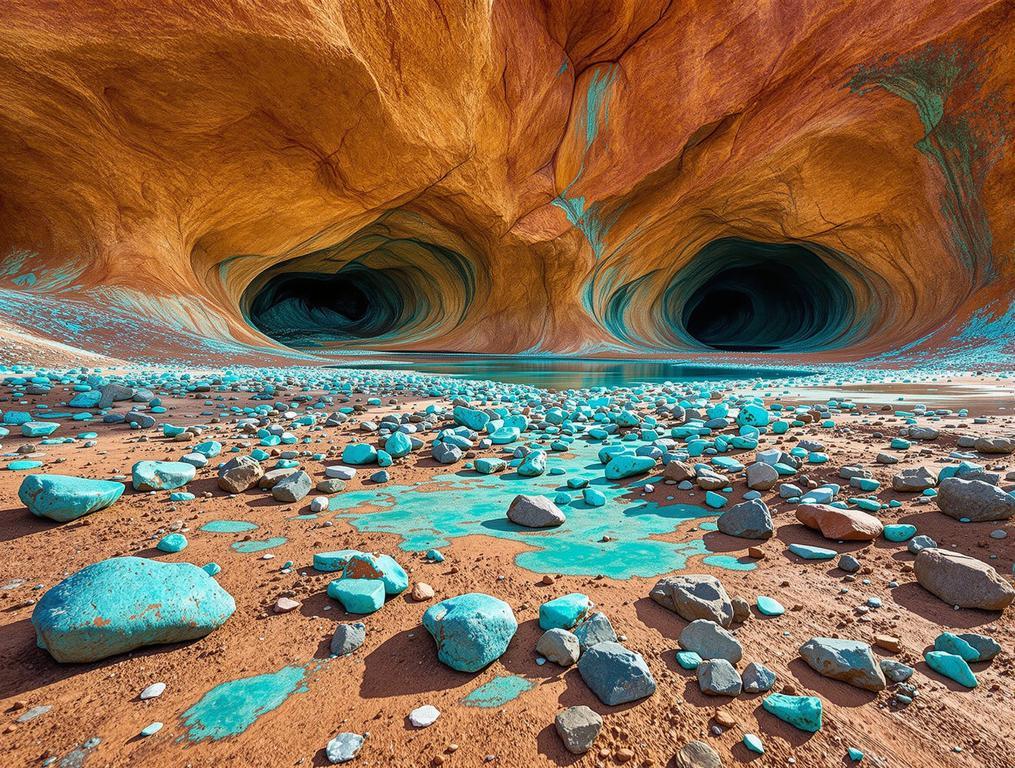I step off the dusty two-lane highway onto the unpaved main street of Cerrillos, 30 minutes south of Santa Fe. The afternoon sun illuminates weathered storefronts, their wooden porches warped by a century of New Mexican summers. It’s hard to believe this quiet hamlet once roared with 3,000 miners extracting turquoise from the surrounding hills. Today, just 89 residents remain in this 1.4-square-mile living museum, a 92% population decline that somehow preserved rather than destroyed the town’s soul.
Much like Illinois’ Maeystown, Cerrillos demonstrates how tiny communities under 150 residents can preserve outsized cultural treasures. But here, those treasures aren’t just buildings—they’re turquoise mines dating back over 1,000 years, making them among North America’s oldest mineral extraction sites.
The 92% Population Decline That Created a Living Museum
In the 1880s, Cerrillos boomed with 21 saloons, four hotels, and multiple newspapers. Silver and lead drew prospectors initially, but the area’s distinctive blue-green turquoise became its lasting legacy. By the 1950s, industrial mining collapsed, sending the population into free fall.
Rather than becoming another abandoned ghost town, Cerrillos transformed. Its adobe buildings and dirt streets now create an atmosphere so authentically Western that Hollywood regularly films here. Emilio Estevez and Kiefer Sutherland walked these same streets while filming Young Guns in 1988.
The town’s compact footprint—smaller than New York’s Central Park—contains over 2,000 former mine sites, though only a handful remain accessible today. Walking through Cerrillos feels like stepping onto a movie set, except everything is genuinely historical rather than fabricated.
North America’s Oldest Turquoise Mines: A 1,000-Year Legacy
Unlike Arizona’s copper mining towns that left visible scars on the landscape, Cerrillos’ turquoise extraction remained relatively small-scale. Yet its cultural impact was immense. Native Keres and Tewa people mined these hills for over a millennium before Europeans arrived.
Cerrillos Hills State Park offers five miles of hiking trails where visitors can explore historic mine sites. The Jane Calvin Sanchez Trail takes you past shafts where turquoise was extracted using stone tools long before Columbus reached American shores.
“You can hold a piece of turquoise that was formed millions of years ago, mined a thousand years ago, and still valued today. There’s something deeply powerful about that connection across time.”
The Casa Grande Trading Post doubles as a $4 mining museum and, surprisingly, a petting zoo. Inside, rough turquoise nuggets sit alongside polished jewelry made by the owners who proudly declare: “We mine it, we make it, and we sell it!”
From Bustling Saloons to Ghost Town: The Casa Grande Trading Post Story
New Mexico harbors several remarkable time capsules, including the Casa Grande Trading Post. Todd and Patricia Brown have operated this combination general store, museum, and workshop since 1975. Their building dates from the mining boom era.
The trading post preserves the spirit of Western commerce that once defined this town. Alongside turquoise jewelry, visitors find mining artifacts and historical photographs documenting the area’s dramatic transformation from boomtown to near-ghost town.
For $20, local guides offer hand-drawn maps to “pothole” turquoise spots accessible via 4×4 vehicles. These small-scale mining opportunities connect modern visitors to the region’s extractive past in a way few American destinations can match.
Turquoise Trail: The Perfect Summer 2025 Road Trip
Like Washington’s Mazama, Cerrillos aims to welcome visitors without sacrificing its authentic character. The town sits along the Turquoise Trail National Scenic Byway (Highway 14), a 50-mile route connecting Santa Fe to Albuquerque.
Summer 2025 offers ideal conditions for exploring. Temperatures average 75-85°F during day hours, perfect for hiking Cerrillos Hills or horseback riding with Broken Saddle Riding Company. The Thursday farmers’ market (May-October, 4-7pm) showcases local produce and crafts.
Cerrillos Station hosts seasonal markets and yoga classes in a former 19th-century dancehall. For the genuine Western saloon experience, Black Bird Saloon retains original mining-era decor while serving contemporary cocktails.
Preserving Mining Heritage While Embracing the Future
Similar preservation efforts can be found in Nevada, where Mark Twain’s legacy endures, but Cerrillos offers something rarer: active participation in its mining traditions. The Cerrillos Historical Society maintains an extensive database of family stories and mine records available to researchers and curious visitors.
Predictions for 2025 suggest growing interest in heritage tourism will bring more visitors to this hidden gem. Summer’s longer daylight hours (5:30am-8:20pm) maximize exploration time before the September Turquoise Trail Studio Tour brings regional artists together.
As I watch the sunset paint the Cerrillos Hills in shades reminiscent of the turquoise extracted here for centuries, I’m struck by how this tiny dot on the map contains such multitudes. Like a geode that appears ordinary until cracked open, Cerrillos reveals its crystalline beauty only to those who take the time to look beyond the dusty facade. My daughter Emma would love collecting the multicolored stones that still surface after summer rains—living treasures from America’s mineral past.
